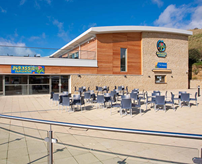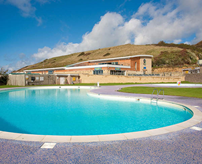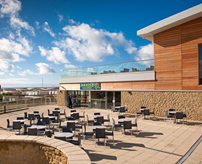Freshwater Holiday Park Case Study
On Dorset's spectacular Jurassic Coast, The Freshwater Holiday Park near Bridport is proving to be no dinosaur and is setting itself apart from other campsites with a brand new £3.5 million leisure complex. In a building which is subjected to the best and worst of British weather, the design had to incorporate insulation versatile enough.
U-value Calculator
Start your U-value calculationPIR insulation for thermal efficient leisure centres
| Products Used: | Celotex CW4000 , Celotex GA4000 |
|---|---|
| Sector: | Retail / Leisure |
On Dorset's spectacular Jurassic Coast, The Freshwater Holiday Park near Bridport is proving to be no dinosaur and is setting itself apart from other campsites with a brand new £3.5 million leisure complex. In a building which is subjected to the best and worst of British weather, the design had to incorporate insulation versatile enough to withstand the dramatically changing weather and climate conditions. High performance floor and wall insulation from leading PIR manufacturer Celotex met the challenge by helping to create a thermally efficient building envelope which was unaffected by temperature cycles.
Designed by HPW architects and built by Vear Construction, the 2000m² multi-use leisure facility forms a welcome addition to this popular holiday park. Close to the sandy delights of the Freshwater Beach, the first rate leisure building includes an indoor swimming pool with slides, a water play area, hot tub, steam room, gym, treatment room, six lanes of full size American ten pin bowling, roof terrace, and bar.
The steel framed building has been designed to combat the extremities of the coastal climate and also offer high levels of energy efficiency, keeping fuel bills low and minimising wasted carbon emissions. Sub contractor, Woodmace Civil Engineering installed 600m² of 100mm thick Celotex CW4000 within the cavity walls and 1500m² of 50mm thick Celotex GA4000 beneath the concrete floors.
Made from PIR (polyisocyanurate) with foil facers for improved emissivity, Celotex CW4000 achieves an excellent lambda of 0.022W/mK, helping the project meet the desired U-values.
Celotex provided 100mm thick CW4000 for the cavity block walls of the steel framed building. These durable and extremely lightweight boards, available in a range of thicknesses from 25mm to 100mm and a standard board size of 1200mm x 450mm, are easy to cut to fit using hand tools making them ideal for a speedy application. In conveniently sized boards for installation between cavity wall ties, once clipped into place, the block walls were built and the exterior of the building was clad to create a weather tight envelope.
To insulate the floor and to avoid loss of heat, 50mm thick Celotex GA4000 was laid on the structural base then covered in poured concrete. Suitable for use in a number of applications including roof, wall and floor systems, Celotex GA4000 has also achieved an A+ rating when compared to the BRE Green Guide 2008, and is available in a board size of 1200mm x 2400mm and a range of thicknesses from 50mm to 100mm.
Now complete, Freshwater's new leisure facility demonstrates the versatility of Celotex' products - offering specifiers reliable and thermally superior products for the effective creation of a thermally efficient leisure facility, and contractors versatile and easy to use products for trouble free installation. The Celotex range represents the pinnacle of PIR insulation with other recognitions such as OFGEM approval.
Key considerations
When using Celotex products, you need to satisfy yourself that use of the product meets all relevant national Building Regulations and guidance as well as local, national and other applicable standards relevant for your construction or application, including requirements in relation to fire and applicable height restrictions. In addition to the product datasheet, please refer to the following product documents:
- BBA certificates - where applicable to the application
- Declarations of Performance
- Health and safety datasheets
Celotex products should not be used in the external walls of buildings over 11 metres in height. Recent changes to Building Regulations mean that only non-combustible insulation or insulation of limited combustibility should be used in buildings of that height.



